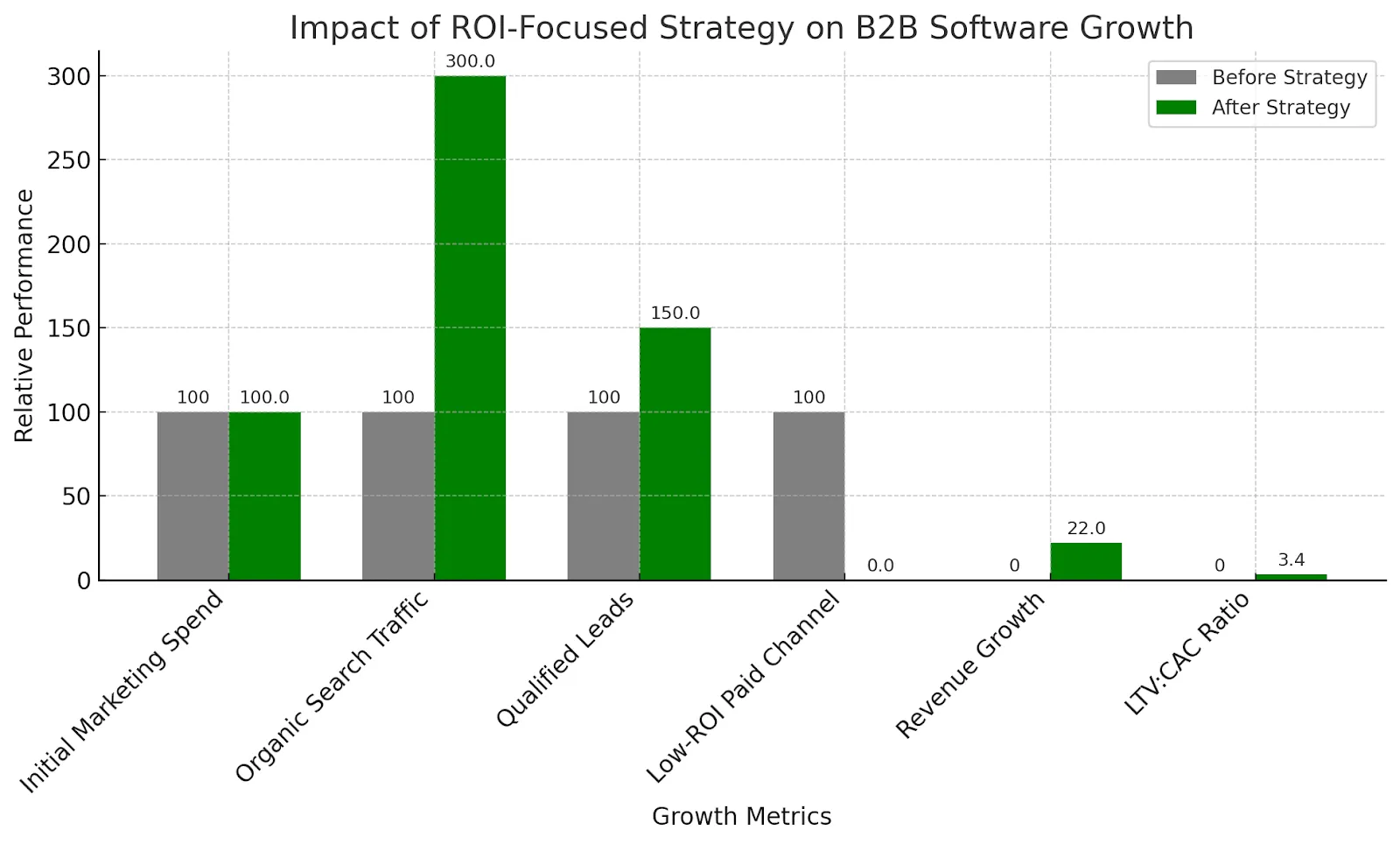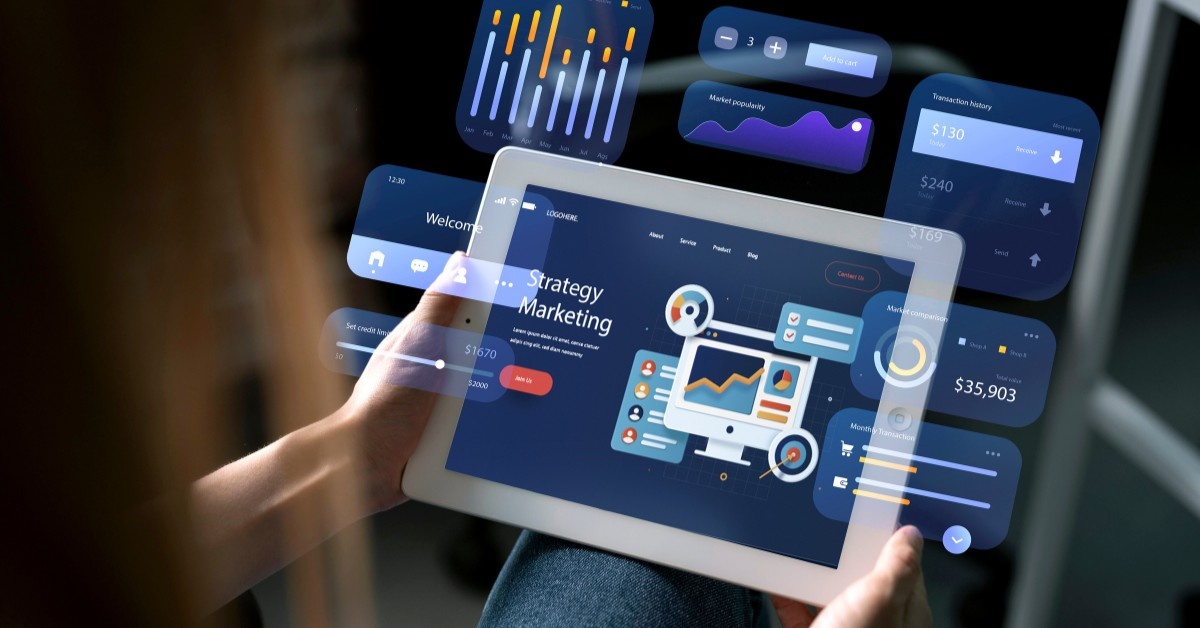Is Your Growth Strategy Stuck in the Past? Here’s How to Rethink ROI in 2025
Most marketers today face one of these two problems. Either their campaigns get plenty of clicks and views, but don't lead to measurable ROI results, or they feel the pressure to adopt every new tool just to stay relevant, without knowing what works.
Growth is not just about chasing customer attention through impressions. It’s about building brand trust, proving impact with metrics, and making smarter bets in a limited time with tighter budgets.
It feels like driving through a modern city using an old road atlas; you might achieve initial sales, but you will surely get lost in the middle and probably take risks that your competitors avoid.
Key takeaways for marketing leaders
- Business growth ROI matters. No Profit leads to no value. Measure CAC, LTV and the LTV: CAC ratio; aim for roughly 3:1
- Align business needs with market realities. Adopt digital transformation early; companies that invest today see higher profits and ROI
- Benchmark against competitors and learn from failures. Many digital initiatives fail due to strategic misalignment. Avoid those pitfalls by setting phased milestones and fostering an agile culture.
- Earn trust through social proof and privacy. Consumers are sensitive to data misuse, and privacy laws are strict. Genuine testimonials and transparent policies build credibility.
- Watch out for emerging trends. AI, privacy, sustainability and outcome‑driven metrics will shape ROI in the near future.
To avoid falling behind, you need to test whether your growth plan is future‑fit and ROI‑focused. To answer this, we need to dive into growth strategy first.
How to create an ROI-focused growth strategy in 2025?
A growth strategy is your long‑term plan for increasing sustainable revenue. It’s not just a marketing campaign; it includes product development, market positioning, customer experience, partnerships and metrics to track progress.
Think of it as an architect’s blueprint: it has a sketch of the house, dimensions, and a laid-out plan for its construction.
Ambiguity with B2B Ad Campaigns

A mid‑size B2B software company saw stagnant revenue despite heavy marketing spend. They relied on search ad campaigns, had no clear LTV: CAC targets and ignored educational content.
They diversified their marketing channels by publishing thought-leadership content, including webinars, blogs, and case studies, and focused on precisely targeted ad campaigns to promote their resources.
This led to boosting their brand awareness, which tripled organic search traffic. Webinars produced 1.5x qualified leads, and the company used positive client testimonials as social proof to close deals faster. By measuring ROI at each stage, they noticed that one paid channel delivered expensive leads with low LTV and shut it down. They ended the year with 22% revenue growth and an LTV: CAC ratio of 3.4:1. The strategy wasn’t some magic; it was disciplined and ROI-oriented.
Five signs that you need to rethink your growth strategy
Besides operational reasons, there are cultural and strategic factors that lead to the failure of a solid growth plan.
Here are some signs that your current growth plan may be stuck in the past:
- Customers are frustrated or leaving. Remember the BlackBerry Storm smartphones in 2008, which suffered from glitchy software and an unresponsive touchscreen, causing mass returns and protests. Customers need to be reassured repeatedly that they are in the right place at the right time.
- No human touch. Some businesses replace genuine user relationships with generic emails and chatbots in the race to achieve a 24/7 response rate. B2B buyers over 35 respond based on familiarity rather than a technology they don’t trust. If your campaigns feel like a system is running them, expect low engagement.
- Decisions aren’t data‑driven. Gut feeling can’t replace real metrics. If you don’t know your LTV: CAC ratio, you’re likely overspending on acquisition or ignoring profitable segments.
- Lack of social proof. In a world of doubts, testimonials and case studies are powerful. Businesses that fail to show evidence of success struggle to convince buyers.
Imagine choosing between two consultants: one presents client stories with measurable results; the other offers only vague claims. Whom would you trust?
- Ignoring emerging trends. Ignoring AI, privacy regulations or sustainability signals today will make your offerings obsolete tomorrow.
If any of these sound familiar, it’s time to rethink your approach.
Why does your brand’s growth feel stuck?
An outdated growth plan is like rowing upstream with a hole in your boat; no matter how fast you paddle, you'll still end up in the water. A good growth plan should be flexible.
A strong growth plan focuses on four things:
- Clear Goals
- The right Audience
- Smart Channels
- Measurable Results
It should help you decide what to invest in, how to reach the right people, what to say to them, and how to know if it's working. Without these basics, even good efforts can lead nowhere.
The most important thing is to check the "Return on Investment" (ROI). This simply means for everything you do, you must ask: "Did we make more money than we spent on this?"
A 7-step guide to build a modern growth strategy for 2025
Rebuilding your growth plan may look like an uphill task, but if you follow a clear roadmap, you will reach your set goals.
1. Start with SMART objectives and KPIs
Define what success looks like to your brand. Tie objectives to outcomes you can measure, such as revenue growth, average deal size or customer retention. For instance: “Grow revenue by 20 % in the next fiscal year while keeping the LTV: CAC ratio at 3:1.” Identify the KPIs that will tell you if you’re on track: conversion rates, churn, net promoter score, and ROI by channel.
2. Uncover demand gaps, not just customer pain points
Instead of just asking customers what they need, look for the unmet needs they haven’t voiced yet. Analyse buying patterns, lost deals, internal use-case workarounds, and where competitors are overserving or underserving the market.
Use tools like Jobs To Be Done (JTBD), win-loss interviews, or qualitative feedback from unsatisfied customers.
This helps you shape demand, not just respond to it.
3. Balance organic and paid efforts
Organic channels, such as educational blogs, podcasts, webinars, and SEO, build trust and authority. Paid campaigns (LinkedIn ads, search ads, sponsored events) provide targeted reach and faster feedback.
Organic is planting orchards for long‑term harvest; paid is buying fruit when you’re hungry. In B2B, leaning 70% organic and 30% paid allows for compounding benefits while still fueling near-term demand.
4. Deploy cross‑functional planning and feedback loops
Growth isn’t the marketing department’s job alone. Sales, product, customer success and finance must align.
Create regular reviews where each team shares data: what objections sales hears, what features users request, and what campaigns drive the highest LTV customers. Use these insights to iterate on your strategy.
5. Conduct competitor benchmarking
Know where you stand in the market. Study your closest competitors and industry leaders (look up to Accenture, IBM or Deloitte in the consulting world).
Compare pricing, service offerings, messaging, client case studies, and digital presence to find the best fit.
Use tools like SWOT analysis and value proposition canvas to identify where you can differentiate.
6. Strengthen mid-funnel momentum
Most growth plans focus on getting attention at the top of the funnel or closing deals at the bottom. The real problem often lies in the middle, where buyers are still exploring but not yet fully convinced.
This is where growth quietly slows down.
Invest in assets that help prospects move from interest to intent. Use case studies, ROI calculators, buying guides, tailored demos, or industry-specific content.
Growth happens when there is clear movement through the funnel.
7. Monitor progress and optimise continuously
Measure performance regularly. Monitor CAC, LTV, LTV: CAC ratio, channel‑specific ROI and retention rates.
If a particular campaign yields high engagement but low conversions, investigate its market fit. Adjust budgets monthly or quarterly based on what’s working.
Future trends shaping ROI and growth in 2025 and beyond
Some of these trends will define ROI-driven growth over the next few years:
1. Privacy First Marketing
People are more careful about how their data is used. Laws like GDPR mean you must ask before collecting data. Rely on your customer's shared data, like an email they enter on your site.
Example: Brands using first-party data have seen up to 2.9x revenue uplift in ad performance according to Google.
2. Focus on real results
Clicks and likes will no longer be enough. What matters is how much revenue your work creates, things like faster sales cycles or more returning customers.
For example, showing how a campaign helped close ten leads, not just how many people saw it
3. Growth with sustainable values
Governments and regulators want brands to act responsibly. Being sustainable and fair is not just a nice idea; it builds long-term trust and protects your brand.
Example: FMCG brands Whole Truth Foods & The Health Factory have set an example by putting honest labels on the ingredient lists and complying with regulations. Thus, leading to a strong brand image among consumers.
Bottom line
Growth in 2025 requires more than ambition. It demands a strategy that’s flexible, measurable and rooted in ROI. Treat your growth plan as a sapling: set clear goals, measure what matters, listen to your customers and adapt to new technologies and regulations.
The companies that succeed will be those that trade outdated playbooks for a modern, human‑centric approach.
Is your business growth stuck, or are you ready to rebuild your strategy?
Why does your brand’s growth feel stuck?
An outdated growth plan is like rowing upstream with a hole in your boat; no matter how fast you paddle, you'll still end up in the water. A good growth plan should be flexible.
A strong growth plan focuses on four things:
- Clear Goals
- The right Audience
- Smart Channels
- Measurable Results
It should help you decide what to invest in, how to reach the right people, what to say to them, and how to know if it's working. Without these basics, even good efforts can lead nowhere.
The most important thing is to check the "Return on Investment" (ROI). This simply means for everything you do, you must ask: "Did we make more money than we spent on this?"
A 7-step guide to build a modern growth strategy for 2025
Rebuilding your growth plan may look like an uphill task, but if you follow a clear roadmap, you will reach your set goals.
1. Start with SMART objectives and KPIs
Define what success looks like to your brand. Tie objectives to outcomes you can measure, such as revenue growth, average deal size or customer retention. For instance: “Grow revenue by 20 % in the next fiscal year while keeping the LTV: CAC ratio at 3:1.” Identify the KPIs that will tell you if you’re on track: conversion rates, churn, net promoter score, and ROI by channel.
2. Uncover demand gaps, not just customer pain points
Instead of just asking customers what they need, look for the unmet needs they haven’t voiced yet. Analyse buying patterns, lost deals, internal use-case workarounds, and where competitors are overserving or underserving the market.
Use tools like Jobs To Be Done (JTBD), win-loss interviews, or qualitative feedback from unsatisfied customers.
This helps you shape demand, not just respond to it.
3. Balance organic and paid efforts
Organic channels, such as educational blogs, podcasts, webinars, and SEO, build trust and authority. Paid campaigns (LinkedIn ads, search ads, sponsored events) provide targeted reach and faster feedback.
Organic is planting orchards for long‑term harvest; paid is buying fruit when you’re hungry. In B2B, leaning 70% organic and 30% paid allows for compounding benefits while still fueling near-term demand.
4. Deploy cross‑functional planning and feedback loops
Growth isn’t the marketing department’s job alone. Sales, product, customer success and finance must align.
Create regular reviews where each team shares data: what objections sales hears, what features users request, and what campaigns drive the highest LTV customers. Use these insights to iterate on your strategy.
5. Conduct competitor benchmarking
Know where you stand in the market. Study your closest competitors and industry leaders (look up to Accenture, IBM or Deloitte in the consulting world).
Compare pricing, service offerings, messaging, client case studies, and digital presence to find the best fit.
Use tools like SWOT analysis and value proposition canvas to identify where you can differentiate.
6. Strengthen mid-funnel momentum
Most growth plans focus on getting attention at the top of the funnel or closing deals at the bottom. The real problem often lies in the middle, where buyers are still exploring but not yet fully convinced.
This is where growth quietly slows down.
Invest in assets that help prospects move from interest to intent. Use case studies, ROI calculators, buying guides, tailored demos, or industry-specific content.
Growth happens when there is clear movement through the funnel.
7. Monitor progress and optimise continuously
Measure performance regularly. Monitor CAC, LTV, LTV: CAC ratio, channel‑specific ROI and retention rates.
If a particular campaign yields high engagement but low conversions, investigate its market fit. Adjust budgets monthly or quarterly based on what’s working.
Future trends shaping ROI and growth in 2025 and beyond
Some of these trends will define ROI-driven growth over the next few years:
1. Privacy First Marketing
People are more careful about how their data is used. Laws like GDPR mean you must ask before collecting data. Rely on your customer's shared data, like an email they enter on your site.
Example: Brands using first-party data have seen up to 2.9x revenue uplift in ad performance according to Google.
2. Focus on real results
Clicks and likes will no longer be enough. What matters is how much revenue your work creates, things like faster sales cycles or more returning customers.
For example, showing how a campaign helped close ten leads, not just how many people saw it
3. Growth with sustainable values
Governments and regulators want brands to act responsibly. Being sustainable and fair is not just a nice idea; it builds long-term trust and protects your brand.
Example: FMCG brands Whole Truth Foods & The Health Factory have set an example by putting honest labels on the ingredient lists and complying with regulations. Thus, leading to a strong brand image among consumers.
Bottom line
Growth in 2025 requires more than ambition. It demands a strategy that’s flexible, measurable and rooted in ROI. Treat your growth plan as a sapling: set clear goals, measure what matters, listen to your customers and adapt to new technologies and regulations.
The companies that succeed will be those that trade outdated playbooks for a modern, human‑centric approach.
Is your business growth stuck, or are you ready to rebuild your strategy?
Do you want more traffic?

How to Scale Personalisation in ABM Without Losing Focus?
.png)
Why Small Tasks Are the Next Big Revolution in Business Efficiency?











